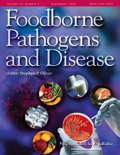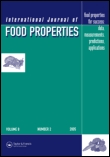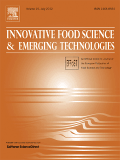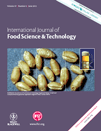
JOURNAL OF FOOD PROTECTION
Scope & Guideline
Transforming food safety knowledge into practice.
Introduction
Aims and Scopes
- Food Safety and Microbiology:
The journal emphasizes research related to foodborne pathogens, their detection, survival, and control strategies, particularly focusing on organisms like Salmonella, Escherichia coli, and Listeria monocytogenes. - Food Processing and Preservation Techniques:
Research is presented on various food processing methods aimed at enhancing food safety, including thermal processing, high-pressure treatments, and the use of natural preservatives. - Risk Assessment and Management:
The journal includes studies that evaluate risks associated with foodborne illnesses, including quantitative risk assessments that help inform policy and regulatory decisions. - Food Quality and Contaminants:
It covers the assessment of chemical contaminants, including pesticide residues, heavy metals, and mycotoxins, and their implications for food safety and public health. - Consumer Behavior and Food Safety Practices:
Research on consumer knowledge, attitudes, and practices regarding food safety is also featured, highlighting the importance of education and communication in preventing foodborne illnesses. - Innovative Detection Techniques:
The journal promotes the development and validation of novel methods for detecting foodborne pathogens and contaminants, including molecular and biochemical techniques.
Trending and Emerging
- Antimicrobial Resistance in Foodborne Pathogens:
There is a growing emphasis on the study of antimicrobial resistance among foodborne pathogens, reflecting global health concerns and the need for effective management strategies. - Impact of Climate Change on Food Safety:
Research exploring the implications of climate change on food safety, including shifts in pathogen prevalence and food production practices, is increasingly prominent. - Food Safety in Novel Food Products:
Emerging themes include the safety assessment of novel food products, such as plant-based alternatives and insect-based foods, which require new safety protocols and research. - Technological Innovations in Food Safety:
The journal is seeing an increase in studies on technological advancements, including the use of biosensors, machine learning, and big data analytics for food safety applications. - Sustainable Food Practices:
Research focusing on sustainable agricultural practices and their impact on food safety is trending, highlighting the intersection of food safety and environmental sustainability.
Declining or Waning
- Traditional Food Safety Methods:
Research focusing solely on conventional food safety methods is less prevalent, as there is a noticeable shift towards innovative and advanced detection and prevention techniques. - General Food Microbiology Studies:
While food microbiology remains a core area, studies that do not focus on specific pathogens or practical applications are becoming less frequent, indicating a trend towards more targeted research. - Food Safety Regulations without Empirical Support:
There is a decline in papers that discuss food safety regulations or policies without providing empirical data or research to support their claims, reflecting a demand for evidence-based approaches. - Broad Consumer Studies:
Research that broadly surveys consumer behavior without a specific focus on actionable insights or practical applications for food safety improvement is becoming less common.
Similar Journals

Foodborne Pathogens and Disease
Innovating solutions for a healthier tomorrow.Foodborne Pathogens and Disease is a leading peer-reviewed journal, published by MARY ANN LIEBERT, INC, that focuses on the critical field of food safety and microbiology. With a robust ISSN of 1535-3141 and an E-ISSN of 1556-7125, this journal has established itself as a pivotal resource since its inception in 2004. It serves as an essential platform for researchers, professionals, and students dedicated to understanding the risks associated with foodborne pathogens and their impact on public health. The journal holds impressive rankings, being categorized in Q1 for Animal Science and Zoology and Q2 for Applied Microbiology and Biotechnology and Food Science according to the latest quartiles. Additionally, it ranks high within Scopus, occupying the 90th percentile in Agricultural and Biological Sciences (Animal Science and Zoology). Though not an open-access publication, it provides valuable insights and data that contribute to the evolving discourse on food safety, the prevention of foodborne diseases, and the advancement of biotechnology in food science. As it converges towards its 20th anniversary in 2024, Foodborne Pathogens and Disease continues to be an indispensable source of information for those committed to the betterment of food safety and public health.

INTERNATIONAL JOURNAL OF FOOD PROPERTIES
Innovating through research in food properties.INTERNATIONAL JOURNAL OF FOOD PROPERTIES, published by TAYLOR & FRANCIS INC, is a leading platform for disseminating high-quality research in the field of food science. With an ISSN of 1094-2912 and E-ISSN of 1532-2386, this journal has been committed to open access since 2018, ensuring that groundbreaking studies are readily available to global audiences. The journal has steadily gained recognition for its contribution to the discipline, achieving a Q2 ranking in Food Science and placing in the 68th percentile among its peers according to Scopus metrics. Covering a wide array of topics related to the properties and applications of food, it serves as a valuable resource for researchers, professionals, and students alike. With coverage extending from 1998 to 2024, the journal continually seeks to advance knowledge and foster innovation within the food science community, making it a pivotal publication for anyone serious about this vital field.

Food Science of Animal Resources
Advancing Knowledge in Animal Science and Food InnovationFood Science of Animal Resources is a prestigious, peer-reviewed journal published by the Korean Society of Food Science and Animal Resources, serving as a vital platform for disseminating advanced research in the fields of Animal Science and Food Science. Since its inception in 2018, the journal has quickly established itself with an impressive Q1 ranking in both categories for 2023, indicating its relevance and influence in the academic community—evident by its ranking of #23 in Animal Science and Zoology and #78 in Food Science among thousands of journals. Operating on an Open Access model since 2019, it enables unrestricted access to cutting-edge research for a global audience, facilitating collaboration and innovation. Its commitment to quality and rigor makes it an essential resource for researchers, professionals, and students dedicated to advancing knowledge in food safety, nutrition, and sustainable practices within the animal resource sector. Set against the vibrant backdrop of South Korea, the journal aims to bridge gaps in knowledge and foster communication among scholars and practitioners worldwide.

Innovative Food Science & Emerging Technologies
Pioneering Research for Tomorrow's Food SolutionsWelcome to Innovative Food Science & Emerging Technologies, a premier journal published by ELSEVIER SCI LTD that serves as a vital platform for researchers and professionals dedicated to the rapidly evolving field of food science. With an impressive Impact Factor and a position in the Q1 category across notable disciplines including Chemistry, Food Science, and Industrial and Manufacturing Engineering, this journal ranks among the top tier within its fields, evidenced by its Scopus ranking of 20th out of 389 in Food Science, placing it in the 94th percentile. Our readers can expect to encounter cutting-edge research and innovative applications from 2000 through 2024, exploring critical themes that contribute to advancements in food technology, manufacturing processes, and sustainability practices. Although currently not an Open Access publication, we maintain a commitment to disseminating high-quality scholarship that enhances knowledge and encourages collaboration among a diverse audience. Join us in driving forward the forefront of food science research in the Netherlands and beyond.

Current Research in Food Science
Transforming Ideas into Food Science SolutionsCurrent Research in Food Science is a leading peer-reviewed academic journal published by Elsevier, specializing in the dynamic field of food science. Since its transition to an Open Access model in 2019, the journal has broadened its reach, contributing significantly to the dissemination of high-quality research. With strong rankings, including a Q1 quartile status in Applied Microbiology and Biotechnology, Biotechnology, and Food Science, it stands out as a pivotal resource for scholars. Based in the Netherlands, current research published within its pages spans a wide range of relevant topics, ensuring that researchers and practitioners stay abreast of the latest advancements. The journal's impressive Scopus rankings enhance its credibility, with a percentile standing in the 74th to 83rd range across relevant categories, underscoring its impact and importance in the academic community. Current Research in Food Science aims to foster the exchange of innovative ideas and foster collaborative efforts among researchers, making it an essential resource for those engaged in advancing the science and technology of food.

RISK ANALYSIS
Uncovering the Dynamics of Safety in Complex SystemsRISK ANALYSIS is a premier journal published by Wiley, focusing on the critical intersection of safety, risk, reliability, and quality within the fields of engineering and physiology. With a strong standing reflected in its Q1 category ranking in Safety, Risk, Reliability and Quality and Q2 in Physiology (medical), this journal is a vital resource for researchers, professionals, and students eager to stay informed on the latest methodologies, theories, and applications surrounding risk assessment and management. Since its inception in 1981, RISK ANALYSIS has been instrumental in shaping the discourse in its fields, garnering a robust reputation verified by its high rankings on Scopus, where it is positioned in the 85th percentile in Safety and the 77th percentile in Medicine. Though it does not currently offer Open Access options, the journal remains essential for those committed to advancing their understanding of risks associated with complex systems. For more insights, RISK ANALYSIS is available to readers throughout its converged years extending to 2024, solidifying its role as a foundational journal for impactful research.

Foods
Exploring the Science of Nutrition and Sustainability.Foods is a premier open access journal published by MDPI, based in Switzerland, that has been at the forefront of disseminating high-quality research in the fields of food science, health professions, and plant science since its establishment in 2012. With an impressive convergence of interdisciplinary studies spanning various aspects of food, nutrition, and microbiology, the journal aims to provide a comprehensive platform for researchers and professionals to share innovative ideas and findings. Maintained as a Q1 journal in multiple categories for 2023, including Food Science and Health Professions, Foods has garnered significant recognition within the academic community, reflected in its strong Scopus rankings and percentiles across various disciplines. The journal not only promotes open access to enhance the visibility and accessibility of research but also encourages the exploration of sustainable food systems and health-related issues, thus contributing to essential discussions in today's society. For those looking to advance their understanding and expertise in food-related sciences, Foods serves as an enduring resource for groundbreaking studies and critical insights.

Applied Food Research
Innovating Insights in Food SystemsApplied Food Research, published by Elsevier, is an esteemed journal that plays a critical role in advancing the field of Food Science. With an ISSN of 2772-5022, the journal has established itself as a premier outlet for high-quality research, achieving a commendable Q1 ranking in the 2023 Food Science category and a 63rd percentile in Scopus rankings for Agricultural and Biological Sciences. Covering a diverse range of topics from food safety to innovative processing techniques, Applied Food Research seeks to publish pioneering studies that enhance our understanding of food systems and contribute to broader discussions on sustainability and nutrition. As it converges on its fourth year of publication, researchers, professionals, and students alike are encouraged to engage with its content through various open access options, ensuring widespread dissemination of knowledge in a field that is vital to global health and well-being. Operating out of Amsterdam, Netherlands, this journal is poised to be an indispensable resource for anyone dedicated to making significant contributions in the domain of food science.

INTERNATIONAL JOURNAL OF FOOD MICROBIOLOGY
Elevating Standards in Food Microbiology ResearchINTERNATIONAL JOURNAL OF FOOD MICROBIOLOGY is a leading journal in the field of food safety and microbiology, published by Elsevier. With an impressive impact factor and a distinguished position, it ranks in the top quartile for both Food Science and Medicine, as well as holding a strong presence in Microbiology and Safety, Risk, Reliability, and Quality categories. The journal provides a vital platform for researchers, professionals, and students to disseminate and discuss innovative research findings and applications that address the complexities of food microbiology. Operating from its headquarters in the Netherlands, this journal not only facilitates access to high-quality scholarly articles but also encourages the development of interdisciplinary approaches to tackle current challenges in food safety and public health. Since its inception in 1984, the journal has continually evolved, ensuring that it remains at the forefront of scientific inquiry, making it a crucial resource for anyone engaged in the food sciences.

INTERNATIONAL JOURNAL OF FOOD SCIENCE AND TECHNOLOGY
Advancing the Future of Food Science and TechnologyINTERNATIONAL JOURNAL OF FOOD SCIENCE AND TECHNOLOGY, published by WILEY, serves as a premier platform for the dissemination of cutting-edge research in the field of food science and technology. With an ISSN of 0950-5423 and E-ISSN 1365-2621, this journal has been committed to publishing high-quality research since 1966 and is set to continue its impactful contributions through 2024. Recognized for its excellence, it holds a Q1 ranking in Food Science and a Q2 ranking in Industrial and Manufacturing Engineering as of 2023. The journal ranks #95/384 in Industrial and Manufacturing Engineering and #100/389 in Food Science on Scopus, placing it within the top quartiles of these fields. Although it does not currently offer Open Access, researchers and professionals benefit from access to a wealth of knowledge that advances understanding in both applied and theoretical aspects of food science. This journal is indispensable for anyone in the academic and professional domains who seeks to stay abreast of innovations and trends shaping the food industry.